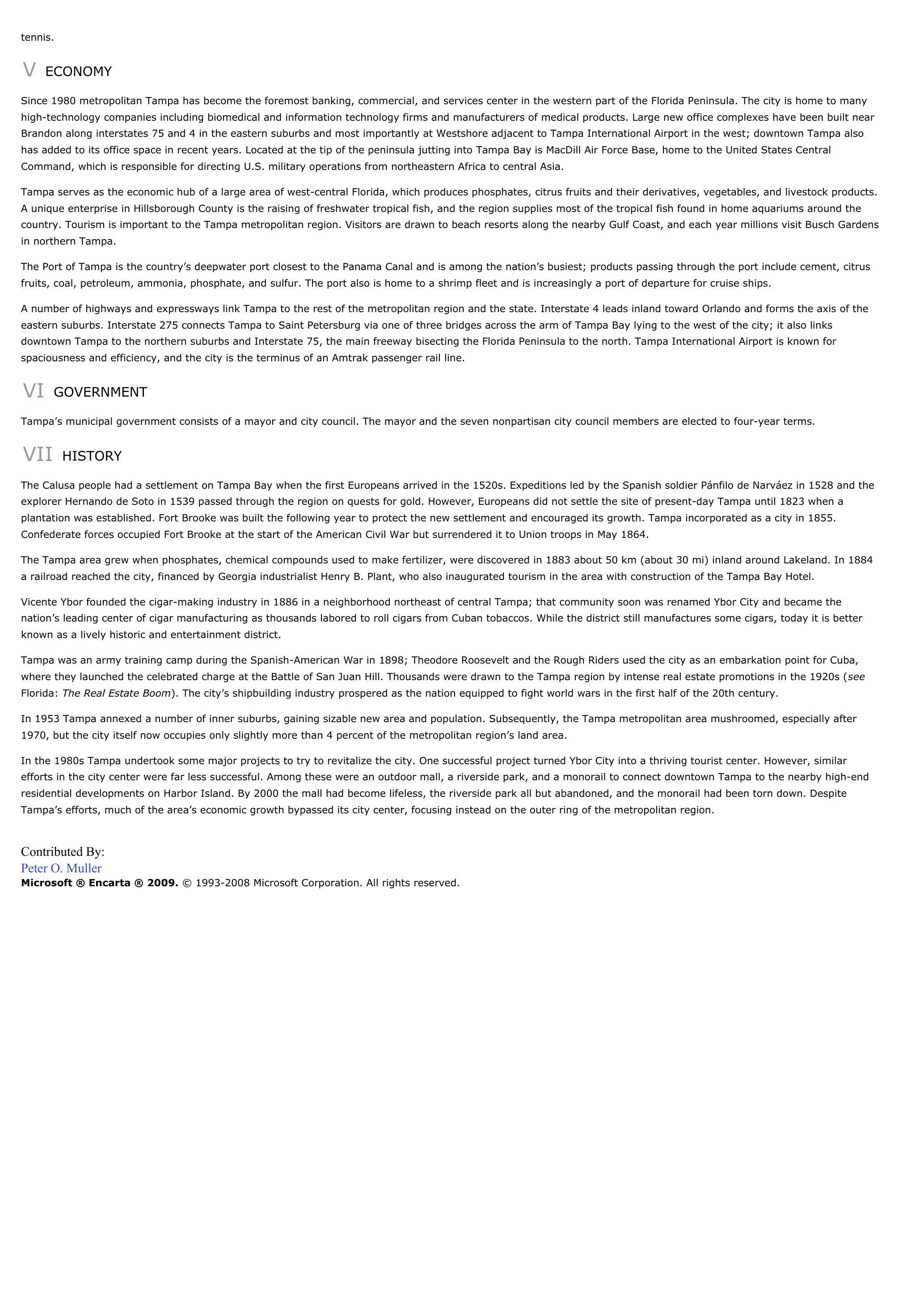Tampa - geography.
Publié le 27/05/2013

Extrait du document
«
tennis.
V ECONOMY
Since 1980 metropolitan Tampa has become the foremost banking, commercial, and services center in the western part of the Florida Peninsula.
The city is home to manyhigh-technology companies including biomedical and information technology firms and manufacturers of medical products.
Large new office complexes have been built nearBrandon along interstates 75 and 4 in the eastern suburbs and most importantly at Westshore adjacent to Tampa International Airport in the west; downtown Tampa alsohas added to its office space in recent years.
Located at the tip of the peninsula jutting into Tampa Bay is MacDill Air Force Base, home to the United States CentralCommand, which is responsible for directing U.S.
military operations from northeastern Africa to central Asia.
Tampa serves as the economic hub of a large area of west-central Florida, which produces phosphates, citrus fruits and their derivatives, vegetables, and livestock products.A unique enterprise in Hillsborough County is the raising of freshwater tropical fish, and the region supplies most of the tropical fish found in home aquariums around thecountry.
Tourism is important to the Tampa metropolitan region.
Visitors are drawn to beach resorts along the nearby Gulf Coast, and each year millions visit Busch Gardensin northern Tampa.
The Port of Tampa is the country’s deepwater port closest to the Panama Canal and is among the nation’s busiest; products passing through the port include cement, citrusfruits, coal, petroleum, ammonia, phosphate, and sulfur.
The port also is home to a shrimp fleet and is increasingly a port of departure for cruise ships.
A number of highways and expressways link Tampa to the rest of the metropolitan region and the state.
Interstate 4 leads inland toward Orlando and forms the axis of theeastern suburbs.
Interstate 275 connects Tampa to Saint Petersburg via one of three bridges across the arm of Tampa Bay lying to the west of the city; it also linksdowntown Tampa to the northern suburbs and Interstate 75, the main freeway bisecting the Florida Peninsula to the north.
Tampa International Airport is known forspaciousness and efficiency, and the city is the terminus of an Amtrak passenger rail line.
VI GOVERNMENT
Tampa’s municipal government consists of a mayor and city council.
The mayor and the seven nonpartisan city council members are elected to four-year terms.
VII HISTORY
The Calusa people had a settlement on Tampa Bay when the first Europeans arrived in the 1520s.
Expeditions led by the Spanish soldier Pánfilo de Narváez in 1528 and theexplorer Hernando de Soto in 1539 passed through the region on quests for gold.
However, Europeans did not settle the site of present-day Tampa until 1823 when aplantation was established.
Fort Brooke was built the following year to protect the new settlement and encouraged its growth.
Tampa incorporated as a city in 1855.Confederate forces occupied Fort Brooke at the start of the American Civil War but surrendered it to Union troops in May 1864.
The Tampa area grew when phosphates, chemical compounds used to make fertilizer, were discovered in 1883 about 50 km (about 30 mi) inland around Lakeland.
In 1884a railroad reached the city, financed by Georgia industrialist Henry B.
Plant, who also inaugurated tourism in the area with construction of the Tampa Bay Hotel.
Vicente Ybor founded the cigar-making industry in 1886 in a neighborhood northeast of central Tampa; that community soon was renamed Ybor City and became thenation’s leading center of cigar manufacturing as thousands labored to roll cigars from Cuban tobaccos.
While the district still manufactures some cigars, today it is betterknown as a lively historic and entertainment district.
Tampa was an army training camp during the Spanish-American War in 1898; Theodore Roosevelt and the Rough Riders used the city as an embarkation point for Cuba,where they launched the celebrated charge at the Battle of San Juan Hill.
Thousands were drawn to the Tampa region by intense real estate promotions in the 1920s ( see Florida: The Real Estate Boom ).
The city’s shipbuilding industry prospered as the nation equipped to fight world wars in the first half of the 20th century.
In 1953 Tampa annexed a number of inner suburbs, gaining sizable new area and population.
Subsequently, the Tampa metropolitan area mushroomed, especially after1970, but the city itself now occupies only slightly more than 4 percent of the metropolitan region’s land area.
In the 1980s Tampa undertook some major projects to try to revitalize the city.
One successful project turned Ybor City into a thriving tourist center.
However, similarefforts in the city center were far less successful.
Among these were an outdoor mall, a riverside park, and a monorail to connect downtown Tampa to the nearby high-endresidential developments on Harbor Island.
By 2000 the mall had become lifeless, the riverside park all but abandoned, and the monorail had been torn down.
DespiteTampa’s efforts, much of the area’s economic growth bypassed its city center, focusing instead on the outer ring of the metropolitan region.
Contributed By:Peter O.
MullerMicrosoft ® Encarta ® 2009. © 1993-2008 Microsoft Corporation.
All rights reserved..
»
↓↓↓ APERÇU DU DOCUMENT ↓↓↓
Liens utiles
- Tampa - geography.
- Tokyo - geography.
- Toronto - geography.
- Venice (Italy) - geography.
- Vienna - geography.

































